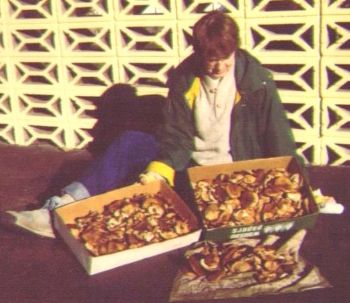
Evelyn with goldentop harvest, October, 1979, Lemont, Illinois
I meet very few people nowadays who really understand mushroom hunting as I knew it, mostly because of my present geographical location. Our family went mushroom hunting in a tradition brought from Poland and other eastern European countries, so northern states in the US have a similar climate. Ever since I can remember, we ate wild mushrooms as part of most evening meals. A typical combination included potatoes, meat, vegetable, bread, and mushrooms. I might have often disliked the meat and vegetable part of the meal, but I never had any problem with the mushrooms. Unlike many life forms, such as plants and animals, which I discovered through personal experience and books, I learned about mushrooms directly from my parents, including which were edible and which were not. The names we gave the species were anything but standard: sheepheads, stumpers, goldentops, buttons. One of my favorites did have a commonly accepted name: the puffball. We also knew about amanitas, especially the death angel, and other highly poisonous fungi. One choice mushroom we never collected or ate was the morel. It grew in the spring instead of the fall, and we had never learned how to properly prepare it.
 Evelyn with goldentop harvest, October, 1979, Lemont, Illinois |
We knew that other people went mushroom hunting, but would never have dreamed of belonging to a club or group. This was because prime mushroom sites were a guarded secret. Family members shared the knowledge (and it was considered proper respect to share the harvest with our grandparents when they were too old to continue hunting for themselves), and very close friends. But, beyond the intimate circle, one did not divulge the whereabouts of a good find, since the next year the same location might again yield a fine crop. It's not like mushroom hunting was unusual in the area south of Chicago, so there was always plenty of competition for the bounty. I remember how quaint I thought it was when I heard about the annual Houby Festival (Czech term for mushrooms) held in our area, but I bet they only celebrated the mushrooms themselves, not the favorite hunting grounds.
When my sister and I were very little, we did not actually accompany my parents on the hunt. We were usually left to play by ourselves in the woods, while Mom and Dad went off to do the collecting. We could never have kept up with the hiking pace, and it was not deemed necessary that we help in gathering. I fondly remember playing little games with millipedes, leaves, rocks, flowers, and anything else we happened to find to keep ourselves amused. We sometimes drew pictures with sticks on the bottom parts of shelf fungus, or collected fallen nuts and seeds. Eventually our parents would come back, lugging baskets full of mushrooms and we'd head home for the next part of the ritual.
Cleaning mushrooms was at least as time consuming as preparing freshly caught fish. The mushrooms had to be individually inspected, washed under running water, and all visible bugs and dirt removed. In the case of sheepheads (large mushrooms weighing several pounds), they needed to be cut up too. Next, the mushrooms were parboiled. It was interesting to see all the missed creatures float to the surface of the water. After that, single meal servings were packaged in plastic bags, labeled, and frozen. We kept a huge freezer in our garage that was mainly for the purpose of storing the year's harvest.
 John and friend, Swede, with sheepheads, October, 1989, Lemont, Illinois |
After John and Evelyn moved to Florida, they continued to make trips back up to Illinois in the fall for the mushroom season. The last wild mushrooms I ate were Christmas gifts from my parents back in 1999, carefully packaged and transported from Illinois, to Florida, and finally here to Texas. My sister continues to hunt mushrooms on and near the Wisconsin farm where she lives. It's been so long since I've done any mushroom hunting that I am not sure I could still recognize some of the species we once ate all the time.
Although we consumed mushrooms year 'round, the hunting season was limited to just a few weeks in the fall. The exact time would vary depending on temperature and precipitation, but it was always around the end of September and into October. Not only was the mushroom crop a prize in itself, but the chance to get out and enjoy the woods during autumn was an experience not to be missed. The smell of the decaying leaves and fungi, the cold tinge to the air, and the silence of the woods have left indelible and cherished images in my memory.